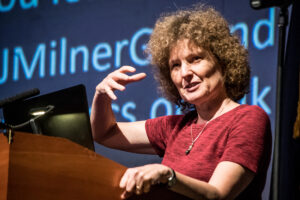Learning to ‘Go Green’ – Undergraduate Delaney McFaden reflects on the Mitchell Lecture
In my first month at college, I’ve had more reminders to “go green” than I have throughout the 18 years of my life. Almost everywhere you turn on campus, there are recycling bins. Members of the Green Campus Initiative, a club dedicated to sustainability, have given out free reusable straws on numerous occasions. I’ve even attended a climate march – something I was never able to do in my hometown. My college, the University of Maine, has a serious commitment to the betterment of the planet. A part of this is hosting a yearly lecture about sustainability. This year, the lecturer was E.J. Milner-Gulland, a professor at the University of Oxford. She has been a dedicated conservationist for 30 years, leading the Interdisciplinary Centre for Conservation Sciences and Conservation Optimism, as well as aiding in the preservation of the Saiga antelope.

Before attending the University of Maine, I lived in a conservative area with a large number of people denying that climate change is happening or that humans play a large part in it. More people continue to deny that the state of the planet is worsening, whether out of an inability to accept reality or choosing not to believe it. My father is one of the latter – rather than take steps towards a smaller carbon footprint and increased sustainability, he chooses not to care about his impact on the planet because “there’s a supervolcano under Yellowstone that could kill us at any moment.” In the face of people like my father, it’s easy to feel small. It was only when I encountered people who comprehended the severity of climate change that I felt heard. For them, I’ve experienced two approaches: a negative and a positive. Those with the negative view have focused on everything bad happening without any recognition of how things have improved. Those with the positive view have focused on only the good, ignoring the negative events happening and how we can prevent them. I’ve always struggled with finding a balance – focusing too much on the negative harms my mental health while focusing too much on the positive feels naive. When walking into a lecture titled “An Optimistic Vision for a Sustainable, Wild, and Socially Just World,” I was afraid that E.J. would align with those that I felt were naively positive.
I soon realized that my fears were unfounded. E.J. discussed in detail how we’ve harmed our planet and how society has changed to be more cognizant of the damage our existence causes. During the lecture, E.J. discussed social change. She described the way that society has changed in the past – first, a small group holds a belief. In a very long and slow process, that belief spreads to more people. She compared this to “walking through treacle” – it will take a long time, but eventually, there will be more and more action that will eventually lead to widespread change. Right now, it feels like we’re walking through treacle. Minds are being changed at what feels like too slow of a pace. However, slow change is change nonetheless, but I still didn’t know how to approach my personal impact on the world.
Further into the lecture, E.J. outlined how she went about implementing change. E.J. is the leader of an organization called Interdisciplinary Centre for Conservation Science. Through this, she and a team of conservationists travel around the world to help areas with loss of biodiversity. When discussing nature and how its impact is considered in infrastructure projects, she talked about strategies to preserve biodiversity. She discussed a mitigation strategy that consisted of four steps: avoiding, minimizing, remediating, and offsetting. You start by avoiding as much loss of biodiversity as possible, then minimizing the losses that do occur. Once the losses are made, you do what you can to remediate them, and then you create gains in other areas. Once she explained this, I began to wonder how I could apply it to my life.
 Growing up, I always heard the phrase “reduce, reuse, recycle.” Reduce the non-eco-friendly objects you have, reuse what you can, and recycle everything possible. This phrase has always felt vague – as I grew older and more aware of the nuances of the term “eco-friendly,” I grew more and more unsure of how to apply it. E.J.’s mitigation strategy is “reduce, reuse, recycle” on a more advanced scale. Avoid practices that are harmful to the planet. Minimize the harm you cause. Remediate and offset that harm however you can. Her mitigation strategy, although designed for infrastructure projects, has very real applications in individual lives.
Growing up, I always heard the phrase “reduce, reuse, recycle.” Reduce the non-eco-friendly objects you have, reuse what you can, and recycle everything possible. This phrase has always felt vague – as I grew older and more aware of the nuances of the term “eco-friendly,” I grew more and more unsure of how to apply it. E.J.’s mitigation strategy is “reduce, reuse, recycle” on a more advanced scale. Avoid practices that are harmful to the planet. Minimize the harm you cause. Remediate and offset that harm however you can. Her mitigation strategy, although designed for infrastructure projects, has very real applications in individual lives.
I left the lecture with a sense of purpose. The mitigation strategies that E.J. outlined provided me with a sense of direction. Yes, the state of the planet is worsening. Yes, some people don’t believe in that. Yes, it can feel like we’ve done too little, too late. However, even with all the overwhelming negatives, there has been an increase in international action to help save the earth that we live on. The realities of climate change are beginning to become more serious, leaving more people to believe in it. Politicians are listening to their constituents and taking action. EJ reminded me that although we are walking through treacle, change is coming. But that change doesn’t magically happen. Large corporations, governments, and every person on this planet need to take steps towards that change. We as a species are the primary cause of the declining health of the planet. But we as a species are taking steps in the right direction to avoid, minimize, remediate, and offset the effects of climate change.
Delaney McFaden
Undergraduate Student
Honors College
